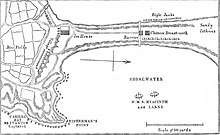Battle of the Barrier
The Battle of the Barrier was fought between British and Chinese forces at the boundary separating Macau from the Chinese mainland on 19 August 1840 during the First Opium War. Located in modern-day Portas do Cerco, Macau was connected to Xiangshan Island by a narrow isthmus about 100 m (330 ft) wide and 1.2 km (0.75 mi) long.[5] A wall called the Barrier was built across the isthmus in 1573, and it served as Macau's border.[6]
Battle

At about noon on 19 August 1840, British corvettes, accompanied by the cutter Louisa and steamer Enterprise, having seamen and marines of the Druid with Bengal Volunteers on board, attacked the barrier.[7] Lord Henry John Spencer-Churchill, son of the 5th Duke of Marlborough and the great-great-grand uncle of Winston Churchill, commanded the Druid until his death in Macau on 2 June 1840 from dysentery.[8][9] The vessels opened fire on a battery about 600 yards (550 m) away, which promptly returned fire.[7]
A British officer wrote: "The [Chinese] junks, which were aground in the inner harbour, were utterly useless, for none of their guns could be brought to bear, though several of the thirty-two pound shots of the ships found their way over the bank, much to the consternation of the occupants of the junks."[7][10] In less than an hour, the batteries were silenced and the British forces landed. They consisted of a brigade of 380 men comprising 110 Royal Marines, 90 seamen from the Druid, and 180 troops from the Bengal Volunteers.[2]
Notes
References
- Bingham, John Elliot (1843). Narrative of the Expedition to China (2nd ed.). Volume 1. London: Henry Colburn.
- The Chinese Repository. Volume 9. 1840. pp. 237–239.
- Fei, Chengkang (1996). Macao 400 Years. Translated by Wang Yintong and Sarah K. Schneewind. Shanghai: Shanghai Academy of Social Sciences.
- Garrett, Richard J. (2010). The Defences of Macau: Forts, Ships and Weapons Over 450 Years. Hong Kong: Hong Kong University Press. ISBN 978-988-8028-49-8.
- Hughes, Jeremiah (1841). Niles' National Register. Volume 59. Baltimore: Jeremiah Hughes.
- Ride, Lindsay (1963). "The Old Protestant Cemetery in Macao". Journal of the Hong Kong Branch of the Royal Asiatic Society 3: 18.
- Urban, Sylvanus (1841). The Gentleman's Magazine. Volume 15. New Series. London: William Pickering.
